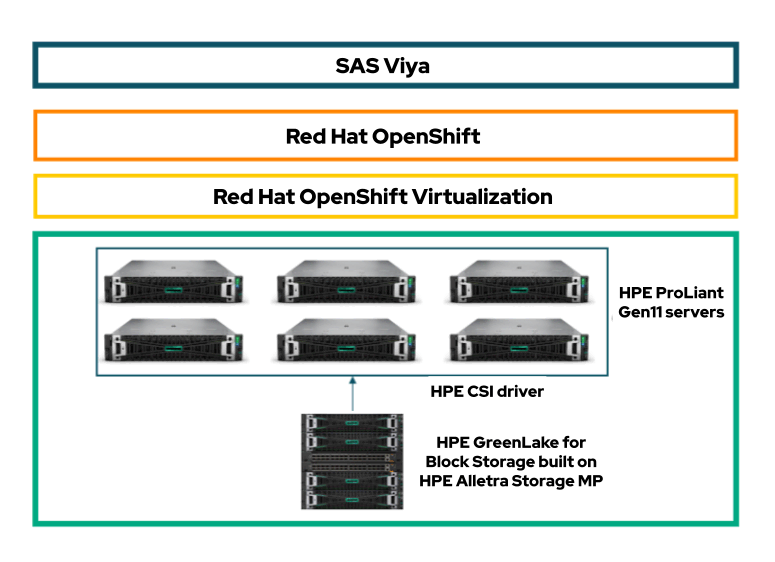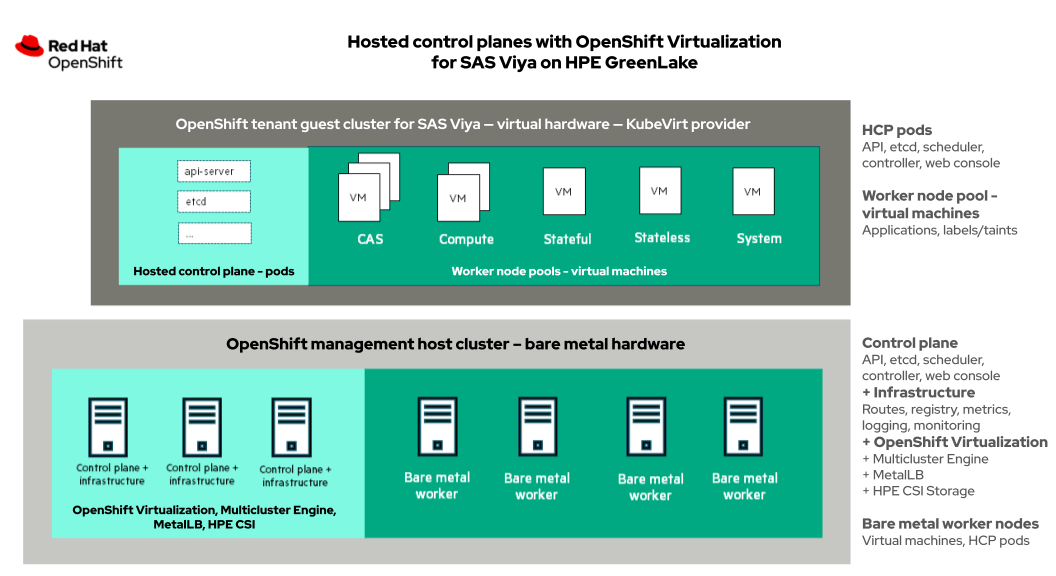SAS Viya is a high-performance AI and analytics platform based on a modern, containerized microservices-based architecture that enables data-driven decisions with high speed and agility. SAS Viya makes it possible for users of all skills and at every level of the organization—from data scientists, to business analysts, to executives—to collaborate and scale while operationalizing discovery and decision-making.
This blog discusses the solution architecture built by SAS in collaboration with Hewlett Packard Enterprise (HPE) and Red Hat for SAS Viya deployment on-premises. It uses the HPE GreenLake edge-to-cloud platform, which delivers the cloud experience where the data lives, and Red Hat OpenShift, the industry’s leading hybrid cloud application platform powered by Kubernetes for deploying and scaling containerized applications.
Although the public cloud makes it relatively simple to deploy and consume IT and IT services, several SAS customers are finding it difficult to migrate their entire SAS 9 landscapes to the public cloud. The main reasons are:
- Distributed, hybrid nature of their data
- Performance and security concerns
- Reduced control of their data
- Lack of time and resources to plan, test and execute
- Data consolidation, compliance and data protection policies
- Exceedingly high egress costs
Given these considerations, many customers are now looking toward an on-premises or a hybrid cloud approach. That is why the case for deploying SAS Viya on-premises is steadily gaining strength.
Solution overview
SAS has created a solution architecture for SAS Viya on Red Hat OpenShift for on-premises and hybrid cloud environments. In this solution, HPE provides a platform offering with OpenShift running on the latest HPE GreenLake Compute and Storage offerings: HPE ProLiant Gen11 servers and HPE GreenLake for Block Storage built on HPE Alletra Storage MP. This offering is entirely virtualized by using Red Hat OpenShift Virtualization.

Figure 1. HPE solution for SAS Viya on Red Hat OpenShift
Service options
This solution provides customers with multiple service options for solution management—self managed, partner managed or HPE managed. HPE can perform the installation, configuration and day-to-day operation of OpenShift and the underlying HPE GreenLake infrastructure. SAS Viya can be managed by the customer, SAS or a SAS partner.
Solution components
Red Hat OpenShift
Red Hat OpenShift brings together tested and trusted services to reduce the friction of developing, modernizing, deploying, running and managing applications. OpenShift delivers a consistent experience across public cloud, on-premises, hybrid cloud or edge architecture.
Deploying SAS Viya on OpenShift provides a unified, flexible platform to address a variety of business needs spanning from a hardened, enterprise-ready Kubernetes orchestrator to a comprehensive cloud-native application development platform that can be self-managed or used as a fully managed cloud service.
Additionally, Red Hat Advanced Cluster Management for Kubernetes brings many advantages to the overall deployment, including an improved security posture through the use of security access controls, governance and compliance with the enforcement of policies, and simplified deployment and management.

Figure 2. Red Hat OpenShift hosted control planes with OpenShift Virtualization
Figure 2 shows the components of the solution, which uses OpenShift hosted control planes (HCP) with OpenShift Virtualization within an OpenShift management cluster that runs on bare metal HPE ProLiant servers. In this solution, HCP and OpenShift Virtualization support the installation of multiple tenant OpenShift clusters that utilize worker nodes running on virtual machines (VMs).
Red Hat OpenShift Virtualization
OpenShift Virtualization enables you to run and manage VM workloads alongside container workloads. OpenShift Virtualization gives you the capability to deploy SAS Viya on a tenant OpenShift cluster running on VMs as part of the HPE Solution for SAS Viya on OpenShift.
Control plane nodes
A node is a virtual or bare metal machine in a Kubernetes cluster. Control plane nodes host the Kubernetes services that are needed to control the Kubernetes cluster, such as the Kubernetes API server, etcd, Kubernetes controller manager and the Kubernetes scheduler. In OpenShift, the control plane nodes run additional services, including the OpenShift API server, OpenShift controller manager, OpenShift OAuth API server and OpenShift OAuth server.
The management cluster is installed as a compact three-node cluster to provide a highly available OpenShift control plane that marks the three control plane nodes as schedulable, enabling them to also act as worker nodes to run applications. Additional bare metal worker nodes within the management cluster support running VMs using OpenShift Virtualization for the worker nodes within the tenant guest OpenShift cluster(s). The OpenShift management cluster in this solution is considered as infrastructure to support the tenant guest clusters.
The management host cluster uses HCP, which is based on the open source project HyperShift, to consolidate the control planes for multiple tenant guest clusters in hosted mode. The management cluster hosts the tenant cluster control plane, running it as multiple pods within a separate namespace for each guest cluster. Using HCP with OpenShift provides several benefits, including:
- Improved security posture by decoupling the control plane from the data plane
- Lower costs by running many control planes on fewer nodes
- Faster startup times for control planes because the control planes consist of pods that are launched on OpenShift
Worker nodes
Worker nodes host the SAS Viya application container pods. OpenShift environments can have many worker nodes, but, a minimum of two worker nodes are used to provide node redundancy. SAS worked with HPE and Red Hat to build several reference configurations, a.k.a. t-shirt sizes, that provide customers with a starting point. The total count and sizing of worker nodes is determined by the application resource requirements plus additional capacity to plan for node maintenance operations, such as cluster updates.
Within the tenant cluster, SAS Viya workload classes and node pools are used to place the workloads on appropriate worker nodes. The placement of SAS workload classes is enabled by applying predefined Kubernetes node labels and node taints within multiple node pools definitions. SAS Viya workload placement using node pools is not mandatory, but it does provide many benefits, such as enabling you to tailor the cluster topology to workload requirements; for example, by specifying different hardware configurations for nodes with additional storage, with GPU cards and so forth. Additionally, cluster node autoscaling of a node pool can be enabled for SAS Viya workload classes, such as SAS Compute.
HPE GreenLake Compute and Storage
From an HPE GreenLake perspective, this solution consists of HPE ProLiant Gen 11 servers with 4th Gen Intel Xeon Scalable processors and the HPE GreenLake for Block Storage built on HPE Alletra Storage MP.
HPE GreenLake for Block Storage built on HPE Alletra Storage MP is an all-NVME, scale-out, disaggregated block storage offering that has the flexibility to scale performance and capacity independently of each other. It uses the HPE Container Storage Interface (CSI) driver to present storage to the OpenShift layer for dynamic volume provisioning by SAS Viya.
SAS Viya
SAS Viya comes in three kinds of license packages: SAS Viya, SAS Viya Advanced and SAS Viya Enterprise with a small, medium and large t-shirt sizes in each. Red Hat and HPE have created five different hardware configurations in this solution to correspond to the resources required for the nine different SAS Viya license t-shirts.
SAS Viya can access data from virtually any source and integrate code written in several programming languages apart from the SAS programming language—such as Python, Java, R and Lua. It offers several UI-driven low-code or no-code tools to manage data, develop models and deploy insights. SAS Viya offers solutions in the areas of generative AI, machine learning (ML), deep learning, natural language processing (NLP), computer vision, neural networks, intelligent decisioning, advanced analytics and more. It is supported on-premises as well as in the public cloud. The solution detailed in this article is an on-premises option on OpenShift.
Wrap up
SAS Viya on HPE GreenLake and Red Hat OpenShift delivers a scalable and efficient on-premises offering for your AI and analytics use cases. This solution uses OpenShift and OpenShift Virtualization technologies on top of the latest HPE ProLiant Gen11 servers and HPE GreenLake for Block Storage built on HPE Alletra Storage MP. The HPE GreenLake edge-to-cloud platform enables configuration, management and monitoring of your entire IT landscape from a cloud-native single pane of glass. HPE GreenLake gives you the freedom to keep your data wherever it is and bring the cloud experience and cloud-like consumption to it instead of having to move the data to a particular location to access these benefits.
Learn more about this solution in a technical paper.
About the authors
Patrick is an Associate Principal Ecosystem Solutions Architect with the Global Solution Architecture team at Red Hat. He joined Red Hat in 2019 and currently works with our OEM and ISV partner ecosystem. Patrick is passionate about creating AI/ML, infrastructure and platform solutions with OpenShift.
Anshul is a WW Solutions Product Manager and a Technical Marketing Engineer focused on SAS and SAP workloads in the HPE Hybrid Cloud BU. He has 15 years of experience in the fields of SAP, storage, analytics, data protection and data management. He is passionate about creating and delivering solutions that bring value to customers.
Browse by channel
Automation
The latest on IT automation that spans tech, teams, and environments
Artificial intelligence
Explore the platforms and partners building a faster path for AI
Open hybrid cloud
Explore how we build a more flexible future with hybrid cloud
Security
Explore how we reduce risks across environments and technologies
Edge computing
Updates on the solutions that simplify infrastructure at the edge
Infrastructure
Stay up to date on the world’s leading enterprise Linux platform
Applications
The latest on our solutions to the toughest application challenges
Original shows
Entertaining stories from the makers and leaders in enterprise tech
Products
- Red Hat Enterprise Linux
- Red Hat OpenShift
- Red Hat Ansible Automation Platform
- Cloud services
- See all products
Tools
- Training and certification
- My account
- Developer resources
- Customer support
- Red Hat value calculator
- Red Hat Ecosystem Catalog
- Find a partner
Try, buy, & sell
Communicate
About Red Hat
We’re the world’s leading provider of enterprise open source solutions—including Linux, cloud, container, and Kubernetes. We deliver hardened solutions that make it easier for enterprises to work across platforms and environments, from the core datacenter to the network edge.
Select a language
Red Hat legal and privacy links
- About Red Hat
- Jobs
- Events
- Locations
- Contact Red Hat
- Red Hat Blog
- Diversity, equity, and inclusion
- Cool Stuff Store
- Red Hat Summit


